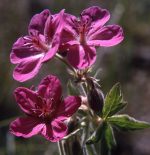 Sticky geranium is a long-lived herbaceous clump-forming perennial and a member of the geranium family, Geraniaceae, that includes both crainsbill (true geraniums) and garden geraniums (Pelargonium). It is native to the mountains and foothills of northwestern North America from Saskatchewan and British Columbia, south to Nevada and California, where it grows in pine forests, mountain meadows, hillside scrub, grassy plains, and wet land-riparian sites. Plants grow 1-3′ tall from a long taproot and have stout branching stems and bright green leaves that are both densely covered with sticky hairs. The palmate leaves are mostly basal, long stalked, and deeply divided into 5-7 toothed lobes. From early spring into summer pinkish-lavender to purple flowers with reddish veins appear in loose clusters well above the leaves. Each saucer-shaped flower is up to 1.5″ wide and has 5 sepals and 5 long, rounded, slightly notched petal. The fruits are hairy and have a long beak shaped like a crane’s neck, hence the common name crainsbill. The seeds are tipped with an elongated tail that coils with maturity and facilitates seed dissemination. The genus name, Geranium comes from the Greek word geranos meaning crane and refers to appearance of the seed. The specific epithet, viscossissimum, is the from the Latin word visco meaning to make sticky and refers to the the leaves and stems of the plant.
Sticky geranium is a long-lived herbaceous clump-forming perennial and a member of the geranium family, Geraniaceae, that includes both crainsbill (true geraniums) and garden geraniums (Pelargonium). It is native to the mountains and foothills of northwestern North America from Saskatchewan and British Columbia, south to Nevada and California, where it grows in pine forests, mountain meadows, hillside scrub, grassy plains, and wet land-riparian sites. Plants grow 1-3′ tall from a long taproot and have stout branching stems and bright green leaves that are both densely covered with sticky hairs. The palmate leaves are mostly basal, long stalked, and deeply divided into 5-7 toothed lobes. From early spring into summer pinkish-lavender to purple flowers with reddish veins appear in loose clusters well above the leaves. Each saucer-shaped flower is up to 1.5″ wide and has 5 sepals and 5 long, rounded, slightly notched petal. The fruits are hairy and have a long beak shaped like a crane’s neck, hence the common name crainsbill. The seeds are tipped with an elongated tail that coils with maturity and facilitates seed dissemination. The genus name, Geranium comes from the Greek word geranos meaning crane and refers to appearance of the seed. The specific epithet, viscossissimum, is the from the Latin word visco meaning to make sticky and refers to the the leaves and stems of the plant.
Type: Herbaceous perennial
Bloom: Loose clusters of pinkish to lavender to purple flowers with reddish veins from slate spring into summer
Size: 1-3′ H x 1- 1.5′ W
Light: Full sun to light shade
Soil: Average to lean, consistently moist, well-drained; drought tolerant once established.
Hardiness: Zones 3-9
Care: Divide every few years
Pests and Diseases: Aphids, tobacco budworms, powdery mildew
Propagation: Seed, division
Companion Plants: Rabbitbush, lupine, larkspur, sedges
Photo Credit: RG Johnson Wikipedia